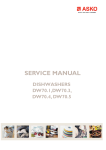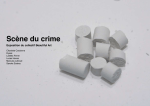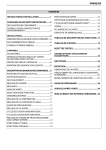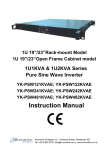Download Asko DW Outdoor Service manual
Transcript
Service manual Dishwasher - DW Outdoor Service manual DW Outdoor 2 Service manual Contents Type: DW Outdoor Updates ..................................................................................................................................................................................................................................................4 Introduction .........................................................................................................................................................................................................................................5 Troubleshooting strategy ............................................................................................................................................................................................................6 Types ........................................................................................................................................................................................................................................................7 Technical data......................................................................................................................................................................................................................................8 Component description ...............................................................................................................................................................................................................9 Components and measurement values .........................................................................................................................................................................9 Components and function description ...................................................................................................................................................................... 10 Programs and control unit........................................................................................................................................................................................................ 14 Wiring diagram ......................................................................................................................................................................................................................... 14 Troubleshooting .............................................................................................................................................................................................................................. 16 Dishwashing results ............................................................................................................................................................................................................... 16 Common faults.......................................................................................................................................................................................................................... 16 Water level DW90 .................................................................................................................................................................................................................. 17 Fault indicaton ............................................................................................................................................................................................................................ 18 Tools / Special tools ................................................................................................................................................................................................................. 18 Fault and information codes .............................................................................................................................................................................................. 19 Service menu and settings........................................................................................................................................................................................................ 20 Service and installation ............................................................................................................................................................................................................... 22 Disassembling and reassembling the machine’s casing........................................................................................................................................ 22 Increased working space during service ..................................................................................................................................................................... 25 Overflow guard wiring .......................................................................................................................................................................................................... 26 Service manual DW Outdoor Updates Rev Date Description Initials 01 2011-09-29 First version FH 02 2011-10-20 New document structure FH 03 2011-11-15 Updated wiring diagram ISC 4 Service manual DW Outdoor Introduction You are holding the Service manual for the DW90 generation of dishwashers. The DW90 dishwasher series is available in several different models. The DW Outdoor model, that this guide is focusing on, is designed for outdoor use. The type designation is most important when identifying a particular machine model. This information can be found on the serial number plate on the right of the inside of the door, where the machine’s model designation is specified. TYPE MODEL SERIAL NO The first two digits of the serial number specify the year of manufacture while the third and fourth digits specify the week of manufacture. The remaining digits form the sequential number. It should be easy to service a dishwasher. It is important that you, as a service technician, are afforded conditions that enable you to work in an efficient and satisfactory way. Our hope is that this service manual will prove a useful tool in your daily work. Asko Appliances AB SE-534 82 Vara Sweden OPERATING INSTRUCTIONS Always have the operating instructions for the machine available during service 5 Service manual DW Outdoor Troubleshooting strategy Troubleshooting is an important part of the service call, so we have drawn up a troubleshooting strategy that describes, in broad terms and step by step, what you need to do to find and diagnose faults arising in our machines. • Ask the customer to describe the problem. • Check whether the customer’s description matches the reported fault. • Check that the machine is correctly installed: - Electrical connection - Drainage - Water connection - Machine correctly levelled Fault found? No Yes Incorrect installation or external factors that affect performance and functionality (for example, water pressure, electrical supply, drainage). The machine operates normally. No deviations can be found. The customer probably needs to be informed about proper use of the machine. If necessary, also inform the customer about the warranty conditions and the fact that the customer will be charged for the service call. Open the service menu: 1. Check the settings 2. Run a test cycle 3. Note any fault codes If the above actions do not uncover the fault: • Conduct general troubleshooting. Use the documentation available at ServiceSaver (service manuals, service memos, wiring diagrams and other documents). Fault found? Fault diagnosed? Yes Yes No Yes OK? No Repair and check function/safety. Contact technical support for assistance. Carry out the actions suggested by technical support. Satisfied customer! 6 No Service manual DW Outdoor Types DW Outdoor The machine has 9 set programs, but can be specified with up to 16 programs. The touch buttons and display are usually found on the top. Certain variants are supplied with a display on the front. 7 Service manual DW Outdoor Dimensions Height US 35” to 35 3/4” Metric 889-908 mm Width 24 5/8” 625 mm Depth (inkl. High loop) 25” 635 mm Depth W/Handle 27” 686 mm Depth W/Door open 51 5/8” 1311 mm Weight (freestanding) 163 lb 74 kg 27" 686 mm 24-5/8" 625 mm 51-5/8" 1311 mm 146 mm to 168 mm 5-3/4" to 6-5/8" 35" to 35-3/4" 889 to 908 mm 25" 635 mm 3-1/2" 89 mm Door 4-7/8" 124 mm Technical Data Connection 1-phase, 120V, 60 Hz, 15 A** 1-phase, 230 V, 50/60 Hz, 10 A/16 A** Water pressure 0.03–1.0 MPa 0.3–10 kp/cm2 4.3-140 psi Heating element 1200 W** 1600 W** Max. rated power 1300 W** 1700 W** * According to EN 50242 standard. ** See type plate. 8 3-7/8" 98 mm 9-1/2" 241 mm Service manual DW Outdoor Component description Components and measurement values The specified resistance values apply at room temperature (about 20°C/68°F) Values within ±10% are considered normal. Article no. Component 8073779 8083041 8079504 8079505 8078096 8083094 8083095 8078080 8078080 8078082 8078082 8078087 8078089 8079502 8079503 8079500 8079501 8073830 8084147 EMC-filter with inductor Filter with screwplint Heating element 1600 W 230 V Heating element 1200 W 120 V Thermistor Combi disp. 230 V Combi disp. 120 V Circ.pump 220-240 V 50 Hz, 47 L (12.4 gallon)/min Circ.pump 220-240 V 50 Hz Circ.pump 120 V 60 Hz, 47 L (12.4 gallon)/min Circ.pump 120 V 60 Hz Drain pump 200-240 V 50 Hz, 16 L (4.2 gallon)/min Drain pump 120V 60 Hz, 16 L (4.2 gallon)/min Inlet valve single 200-240 V, 4 L (1 gallon)/min Inlet valve single 120 V, 4 L (1 gallon)/min Inlet valve security 220-240 V, 4 L (1 gallon)/min Inlet valve security 120 V, 4 L (1 gallon)/min Halogen lamp 5 W/12 V Thermo Actuator 110-240 V Measurement value Primary winding 680 kohm 1 Mohm 32 ohm 12 ohm 60 kohm 1,32 kohm 285 ohm 115 ohm Auxiliary winding 260 ohm Primary winding 31,4 ohm Auxiliary winding 76 ohm 148 ohm 26 ohm 3,9 kohm 0,95 kohm 2 kohm 0,5 kohm <10 kohm 0,85-1,2 kohm * The number is for a complete water softener; replacement salt and mixer valves are not available separately. 9 Service manual DW Outdoor Component description Components and function description Here we describe the function and specification of the most important components. Certain components are found only in more highly specified machines or in particular markets. See the Troubleshooting section for fault and information codes. CU, Control Unit The CU, or Control Unit, is a unit that functions as both a control panel and a logic component. The control panel is fitted with a display and touch buttons for selecting programs, options and Start/ Stop. The control panel is an integrated part of the CU and cannot be replaced separately. The logic component manages functions needed for dishwashing programs and diagnosis. The CU has an internal power supply for the logic. In the event of a fault, the CU can diagnose a number of components and functions and display fault codes. To facilitate troubleshooting the service menu includes a component diagnostics function, which activates the outputs in a particular sequence. Accelerometer The control unit contains an accelerometer, a sensor that senses position and acceleration. It controls the touch buttons and the brightness of the light. The accelerometer turns off at a specific angle to avoid causing a distraction when seen from the worktop. It is calibrated when the door is closed. If this symbol appears on the display the door is not open enough. Open the door until the display lights up. Inlet valve The inlet valve has an electrical connector that is coded to ensure it is not mixed up. It is fitted with a filter, which can be removed for cleaning. Both single and safety valves are used as inlet valves. The inlet valve contains a filter to stop particles then a flow limiter to limit the flow to a maximum of 4 L (1 gallon)/min. It opens when the water pressure exceeds 0.3 bar (4.3 psi) and provides full flow at about 2 bar (29 psi). It has a pressure range of 0.3 bar (4.3 psi) to 10 bar (145 psi). The inlet valve is fitted to the air gap and can be replaced from the rear of the machine. Purpose: To ensure that the machine is supplied with water for the different dishwashing cycles. Safety valve The safety valve has two independent valve seats, each controlled by a separate electromagnet. The valve seats are connected in series. This doubles the safety factor. The electromagnets are also connected in series (electrically), which means each magnet’s rated voltage is half the line voltage (e.g., a 230 V valve = 2 x 115 V coils) Single valve The single valve comprises an electromagnet and a valve seat. 10 Service manual DW Outdoor Component description Flow meter Flow meter The flow meter is fitted in the air gap and cannot be replaced separately. It comprises an impeller that is rotated by the flow of water from the inlet valve. The impeller is fitted with two magnets that affect a sensor, a so-called reed switch. This is connected to the control unit via a wire and provides the control unit with information on the amount of water entering the machine. In order for the flow sensor to function normally the incoming water pressure must be at least 2 bar (29 psi). Output signal: 220 pulses per liter (0.26 gallon) of water flowing through. Circulation pump The circulation pump comprises an asynchronous motor with a capacitor and a pump housing with an impeller. The impeller and seals cannot be replaced separately, rather the entire pump must be replaced. The circulation pump can be rated 220-240V, 50/60Hz, as well as 120V, 60Hz. Purpose: To provide the spray system with the water pressure necessary for the dishwashing process. Heating element The heating element is of the flow-through type and is fitted between the bottom drain and the suction connector of the circulation pump. It comprises a pipe with a heating coil. One side of the heating coil is fitted with an overheating cut-out with a trigger temperature of 98°C (208°F) and an automatic reset. The other side is fitted with a safety fuse that blows at 229°C (444°F). The element is replaced from the rear of the machine by first moving the circulation pump out of the way. Purpose: To heat the dishwater to the correct temperature during the prewash/main wash and final rinse. Drain pump The drain pump is fitted to the bottom drain and can be replaced from the front of the machine. In the bottom drain, under the filters, is a access plug which when removed enables the customer to clean the pump housing. In the event of a blockage the pump changes its direction of rotation to try to clear the blockage. Purpose: To drain the water from the cleaning compartment in accordance with the program specification and in case of overflow. 11 Service manual DW Outdoor Component description Detergent and rinse aid dispenser The dispenser has one container for detergent and one container for rinse aid. The containers are opened by activating the electromagnet found on the lock of each container. When first activated detergent is dispensed and when activated a second time rinse aid is dispensed. A weight (which is activated when the door is opened for loading and unloading) resets the mechanism so that the dispenser always dispenses detergent first when a new program is started. Door switch A micro switch detects when the door has been opened. The programs is paused and power to certain components (circulation pump, valves and more) is cut. The programs continues where it left off when the door is closed. If a program is running the machine indicates that the door is open. Purpose: To prevent the machine from running while the door is open. Light The light is a 5 W/12 V halogen bulb powered by the control unit via a micro switch. The lamp is activated when the door is opened more than 5° and automatically deactivated when the door has been open for more than 30 minutes. The control unit features protective components that limit the current to the light in case of a short circuit or if a bulb with too high a power rating is fitted. The bulb can be replaced from inside the cleaning compartment. 12 Air gap The air gap is found next to the cleaning compartment. It comprises channels through which the incoming water flows into the cleaning compartment. These channels also contain an anti-backflow device and the flow sensor through which the water passes. Certain models are equipped with a water pocket that collects water used for the water softener (only machines with a water softener). The air gap also works as a channel of air taken in during the drying phase, as well as a pressure relief for excess air when opening and closing the door. On machines with Turbo Drying Express (TDE) a lid is mounted on the inside of the air gap. If there is condensation in the kitchen interiors, make sure the lid is correctly fitted. Purpose: To prevent dirty water from the cleaning compartment being sucked back into the water supply, and lead air to and from the container. Service manual DW Outdoor Component description Thermistor The thermistor for temperature measurement is located at the front edge of the bottom drain. The thermistor measures and controls the water temperature, which can be up to 70°C (158°F). If the thermistor short-circuits or loses contact with the CU, or of the thermistor does not register a temperature increase of 5°C (41°F) within 10 minutes of the element being activated, the element is switched off and a fault code is indicated. This is only indicated in the service menu. The thermistor is of the NTC type (Negative Temperature Coefficient), i.e. its resistance decreases as temperature increases. Purpose: To control the water temperature during the dishwashing process. EMC filter with inductor The filter is fitted at the front of the base pan and consists of a number of coils, condensers and resistors. Purpose: To eliminate electromagnetic interference to and from the machine. Pressure sensor The pressure sensor is connected to the pressure chamber in the bottom drain. It measures the pressure, which corresponds to the water level in the machine. If the water level in the machine is too high (for five consecutive seconds) the drain pump starts and all other components are switched off. When the correct level is reached, the program continues where it left off. If the level sensor generates an output signal of <1 VDC during the prewash (indicating a blocked filter), an additional prewash is activated with an SCS step. The level sensor also controls the draining time (can be extended from 20 seconds to a maximum of 2 min). The sensor also checks the need to refill (such as if a bowl fills with water). Purpose: To prevent overflow, to detect a ‘blocked filter’, when necessary refill the machine (such as if a bowl has filled with water), and to control the draining time. Overflow guard The overflow guard is integrated with the bottom drain. This overflow guard consists of a micro switch activated by a float if water collects on the machine’s base pan. The micro switch is normally closed. When it is activated, it breaks the circuit to the CU, the drain pump starts, the program is interrupted and the machine indicates an overflow. Purpose: To provide protection from any water leaks or flooding from the machine. Cables The machine is fitted with coded connectors to prevent incorrect wiring. The cables comply with the Rast 2.5 and Rast 5 standards. 13 Service manual DW Outdoor Programs and control unit TH 1/C TS 2 PS 1 23 IS FM SS DIV M 5 IV CD FN 1 VAX CP KD 2 FL VAX 3 CP IV SV SV 4 MV MV DIV SL HL 6 BE I2C DW90.1, DW90.1OEM, DW90.2, DW90.C, DW90.3 HS 7 UART 8 9 GS TS FM SG NTC HS SL Wiring diagram DS RAS CP HE MS DR N TDE F L HE HE (PTC) FN2 HWC 1/C DP 1 FS EL TB VMG 10 14 PTC AP 3/4 FAN 2 LB 3/4 1/C CIRCUIT DIAGRAM DW90.1, DW90.1OEM, DW90.2, DW90.C, DW90.3 80 840 68-01 14 This document must not be copied without our written pemission, and the contents thereof must not be imparted to a third party nor be used for any unauthorized purpose. Contravention will be prosecuted. Asko Appliances AB FORMAT A4 Service manual DW Outdoor KD/CD: COMBI DISPENSER CP: CIRCULATION PUMP DIV: WATER DIVERTER VALVE AP/DP: DRAIN PUMP DR: DOOR LB/DS: DOOR SWITCH F: FILTER FM: FLOW METER FL/FN 1: FAN DOOR FAN/FN 2: FAN BOTTOM FS: FLOAT SWITCH EL/HE: HEATING ELEMENT HE (PTC): HEATING ELEMENT PTC BE/HL: HALOGEN LAMP HS: HUMIDITY SENSOR IS: ILLUM. SWITCH IV: INLET VALVE I2C: I2C TB/MS: MAIN SWITCH MV: MIX VALVE TS/PS: PRESSURE SENSOR VMG/RAS: RINSE AID SENSOR SL: STATUS LIGHT SG/SS: SALT SENSOR SV: SALT VALVE NTC/TH: THERMISTOR GS/TS: TURBIDITY SENSOR UART: UART VAX: VAX ACTUATOR HWC: HOT WATER CIRCUIT WIRES IN ALL MACHINES INTERNAL CONNECTION WIRES IN SOME MACHINES RESISTANCES AT ROOM TEMPERATURE (CA. 20°C/68°F) VALUES WITH +/-10% ARE REGARDED AS NORMAL COMPONENT RADIO INTERFERENCE SUPPRESSION FILTER HEATING ELEMENT 1200W 120V HEATING ELEMENT 1600W 230V HEATING ELEMENT 2040W 230V THERMISTOR COMBINED DISPENSER 120V COMBINED DISPENSER 230V CIRCULATION PUMP 120V 60HZ CIRCULATION PUMP 230V 50HZ CIRCULATION PUMP 220V 60HZ DRAIN PUMP 120V 60HZ DRAIN PUMP 230V 50HZ DRAIN PUMP 230V 60HZ SPRAY ARM DIVIDER 120V 60HZ SPRAY ARM DIVIDER 230V 50/60HZ INLET VALVE SINGLE INCL. 120V INLET VALVE SAFETY INCL. 120V INLET VALVE SINGLE INCL. 230V INLET VALVE SAFETY INCL. 230V SALT VALVE 120V MIX VALVE 120V SALT VALVE 230V MIX VALVE 230V HALOGEN LAMP 5W 12V WAX MOTOR FAN MOTOR 120V FAN MOTOR 230V FAN MOTOR 2 120V FAN MOTOR 2 230V RESISTANCE 1 MOHM 12 OHM 32 OHM 25 OHM 60 KOHM 0,28 KOHM 1,32 KOHM 32 OHM 110 OHM 56 OHM 25 OHM 150 OHM 85 OHM 2.6 KOHM 8,5 KOHM 0.95 KOHM 0.5 KOHM 3,9 KOHM 2 KOHM 0,65 KOHM 0,65 KOHM 3 KOHM 2,3 KOHM <10 KOHM 1.1 KOHM 0.18 KOHM 0,85 KOHM 0,22 KOHM 0,90 KOHM 15 Service manual DW Outdoor Troubleshooting Dishwashing results Check the following points if the dishes are not clean (always begin by checking any fault codes and the most recent fault indication in the service menu): • That the customer is using the right dishwashing program. • If heavily soiled dishes are being loaded, such as pots or oven dishes, choose a heavier program. • Check that the customer is using a suitable dishwashing detergent, preferably one with proven good results. • Detergent is a perishable product. Check that the detergent is not too old and that the customer is using the right amount. Most importantly not too much detergent. • For machines with a water softener, dose as for soft water. • Check that the customer is loading the machine correctly. • Check that no dishes are preventing the spray arms from rotating and that the holes are not clogged. • Check that the machine has the right water level. See the Water level section for more information. • Check that the access plug on the left side of the bottom drain by the drain pump is in place. • Check that the machine heats to the right temperature. Common faults If the dishwasher does not work, you should first check whether this is due to a simple fault, something that the customer can rectify. Use the following questions to troubleshoot the machine. Film or marks on dishes after washing • Is the water softener cover properly tightened? • Is the rinse aid dispenser correctly adjusted? • Is the water softener correctly adjusted? • Is there any salt in the salt compartment? • Is the right type of salt being used? For more information, see the machine’s operating instructions. 16 The machine will not start • Has the house breaker/fuse been tripped or blown? • Has the machine been turned on? • Is the door properly closed? • Is the water supply turned on? If the answer to any of the above questions is “YES” and the machine seems to lack power, first check that there is power at the main power switch and the control unit. Replace any faulty component. Water remaining in the machine • Is the drain hose blocked? Check the connection to the household drain. • Is the drain hose kinked? • Are the filters blocked? • Is the drain pump blocked? • Is the access plug on the left side of the bottom drain by the drain pump incorrectly fitted? If the fault cannot be found with the help of this chapter, open the service menu and perform a function test on all components Service manual DW Outdoor Troubleshooting Water level DW90 When servicing a DW90 dishwasher it is important to check the water level in the machine. This is particularly important when programming the time-controlled water intake. Too low or too high water level can cause poor dishwashing results. Always allow the machine to take in and drain the water a few times before checking the level. Overflow level = 4.7 L (1.24 gallons) Without spray arm diverter = 3.2 L (0.8 gallons) (1.5 mm (1/16”) above the level) With spray arm diverter = 2.95 L (0.7 gallons) (in line with the level) Check the level against the lower spray arm hub In the event of too low water level, the filter in the inlet valve must always be checked and rinsed clean of any sediment. The inlet hose with a 3/4” connection at both ends has a filter in the connector outside the machine that must also be checked and rinsed clean of any sediment. In the US the inlet hose has a 3/8” connection at both ends and no filter in the connector outside the machine. 17 Service manual DW Outdoor Troubleshooting Fault indication DW Outdoor T8 T1 DISPLAY D1, I5, D2, D3 T3 T4 T5 T6 L = LED, S / T = Push button, F = Fault code or plain text on display, D = Display, I = Indication Tools The following tools are needed to service the DW90 dishwasher: Torx T20 T25 T30 Ring spanner/wrench 7 mm 16 mm Fixed open-end wrench, adjustable wrench, polygrip pliers/slip joint pliers For cable fasteners, electrical and inlet valve 22 mm Special tools 8801339 Universal tool, dishwasher 7281370 Hose clamp pliers, Oetiker 8801424 Universal tool, adapter water softener 18 T7 T2 Service manual DW Outdoor Troubleshooting Fault and information codes Audible signal sounds when a fault is indicated on the display. Display Cause Action The door is open Close the door F:41 Temp stop fault Temperature increase less than 5°C (41°F) in ten minutes. Program continues with the process. Only indicated in service menu. Check Element, thermistor, water level, circulation pump, control unit and cables. F:10 Overfilling Too much water in the machine (pressure sensor) or float activated. If the water has not been emptied within 60 seconds, the program stops (drain pump activated). Check Drain pump (blocked hose), flow meter, inlet valve, leaks and cables. F:42 Check Thermistor fault Communication between the Thermistor, plugs, wire harness, and control thermistor and control unit has unit. stopped or the thermistor is reporting temperatures greater than 80°C (176°F). Program continues with the process. Only indicated in service menu. F:12 Water inlet fault < 80 pulses within 60 seconds or correct number of pulses not achieved within 255 seconds. Program stops. Check Water inlet, flow meter, inlet valve and cables. F:40 Inlet valve leakage Water intake detected when inlet valve deactivated in program sequence or standby. In this case the machine attempts to close the valve by opening it for 2 seconds and then closing it again. If water flow through the valve is still detected any current program is stopped (drain pump activated). Check Leak through inlet valve and flow meter. F:43 Pressure sensor fault Output signal > 4.8 V. The program continues. Only indicated in service menu. Check Pressure sensor, control unit and cables. F:11 Water outlet fault Water not drained after 120 seconds draining. Program stops. Check Drain pump, hoses, drain hose fittings, control unit and cables. Also check whether filter is blocked. F:44 Turbidity sensor fault Only indicated in service menu. The machine assumes high turbidity in case of “uncertainty” in the auto program. Check Water quality, filters, turbidity sensor and drain system. F:45 Spray arm diverter fault Position switch always closed or open. The program continues. Only indicated in service menu. Check Spray arm diverter (functioning gearbox, switches and cables). 19 Service manual DW Outdoor Service menu T8 T1 D1, I5, D2, D3 LCD1 T3 T4 T5 T6 T7 T2 Variant 1 Variant 2 Variant 3 Variant 4 Opening the service menu Open the door, put the machine in standby mode by pressing the main power switch (T8). Activate the machine again by pressing the button (T8), press and hold the program selector PROG + START (T1) and (T2) for 5 sec. LCD shows: . When the service menu is opened the most recent error message is shown, F:XX. All error messages are erased by a total reset. It is only possible to leave the service menu by pressing the button (T2). It is not possible to leave the service menu by using the main power switch (T8). START Press the button (T2) to navigate the menu system step by step. PROG Press the button (T1) to scroll between settings. Press (T2) to save the setting and continue to the next menu step. START Press (T2) at the last step of the menu to close the service menu and save the most recent settings. Menu step/Turn/Push LCD Comments/instructions d:01 Mixer valve and inlet valve on (1 second delay between mixer valve, if available, and inlet valve) START Diagnostics d:02 Inlet valve and mixer valve, if available, off for 1 second then inlet valve on d:03 Salt valve on (if available) d:04 Combi dispenser on d:05 Circulation pump on and the spray arm diverter (if available) shall alternate between positions 1 and 3 every 30 seconds d:06 Circulation pump and heater on - max. 75°C (167°F) d:07 Fan and Wax motor and Turbo Drying Express and Heating Water Circuit on d:08 Drain pump on d:00 No components on P:0 Normal water intake volume, default setting P:5 Water intake volume increases by +5% P:10 Water intake volume increases by +10% P:15 Water intake volume increases by +15% L:0 Time, flow meter switched off, intake time: pulse value x 0.068 [s] L:5 Time-controlled water intake increases by +5% L:10 Time-controlled water intake increases by +10% L:15 Time-controlled water intake increases by +15% PROG START Water intake PROG START 20 Service manual DW Outdoor Service menu T8 T1 D1, I5, D2, D3 LCD1 T3 T4 T5 T6 T7 T2 Variant 1 Variant 2 Variant 3 Variant 4 Menu step/Turn/Push LCD Comments/instructions Variant U:1 Variant 1, default setting (Temperature, Drying) U:2 Variant 2 (Temperature, Drying, Delayed start) U:3 Variant 3 (Temperature, Drying, Delayed start, Time program) U:4 Variant 4 (Temperature, Drying, Delayed start, Time saver) EU Region Europe, default setting PROG START Region PROG US Region USA AU Region Australia Y:0 No fan sequence during program. Dries the load. Y:1 Fan works in sequence during the wash cycle, not in normal program, default setting Y:2 Fan works in sequence during the wash cycle, even during normal program A:0 Turbo Drying Express and Heating Water Circuit off, default setting A:1 Turbo Drying Express on (Quick). Uses both hot water system and electrical energy to minimize program time. A:2 Heating Water Circuit on (ECO). Uses hot water system as far as possible, aided by electrical energy, to minimize energy consumption. S:0 Super rinse off, default setting S:1 Super rinse on. Adds two extra rinses. r:0 No total reset next time T2 is pressed, default setting r:1 Total reset next time T2 is pressed. Should be done after replacing the control unit to reset all the sensors. START Fan sequence PROG START TDE & HWC PROG START Super rinse PROG START Total reset PROG START 21 Service manual DW Outdoor Service and installation Disassembling and reassembling the machine’s casing In order to access the machine’s components, first we need to disassemble its casing, either in part or in full. Once servicing is completed, reassemble the casing with care so that it is properly resealed. We recommend wearing gloves and using caution when removing the stainless steel panels that make up the casing of the machine. The panels, once removed, may have unfinished edges that could be sharp. Be careful not to damage the casing and seals during disassembly and reassembly! It’s a good idea to have new seals for the rear motor compartment on hand in case any of them get damaged and need replacing. • 88 015 03 – Sealing kit DW Outdoor Top cover * Remove the hose holder/high loop and undo the top cover screws at the rear of the machine. Then lift and slide the top cover forward 1 cm (1/2”) or so to free the catches on the side panels of the casing. Lift the top cover from the machine. Also undo the screws running through the top edge of the cleaning compartment from inside the machine. Upper and lower rear panels Undo the screws in the rear panel and lift the bottom edge of the panel to free the 22 catches from the slots in the side panels. Remove the rear panel from the machine. Undo the screws in the lower back panel. Service manual DW Outdoor Service and installation Rear motor compartment Undo the screws in the side panel that attach to the cross support. Next undo the screws in the back cover of the motor compartment. Angle out the side panels of the casing and open the back cover. NOTE: The seals in the bushings for the inlet and outlet hoses, as well as for the power cable, may need replacing. Make sure you have new sealing kit on hand before starting any work. Side panels The two side panels of the casing only need to be removed when you need to access the machine’s forward motor compartment and when you need to create more space for servicing the machine (see the ”Increased working space during service” section). The air gap is located inside the right side panel.. Undo the screw in the side panel mount in the rear upper corner. Undo the screw in the cross support at the rear of the machine. Next undo the screws in the back cover of the motor compartment. Finally, open the door and undo the screws holding the side panel in place from the inside. Angle out the top edge of the side panel and then lift the side panel to free it from the catches. The slots in the bottom of the side panel keep it in place. 23 Service manual DW Outdoor Service and installation Forward motor compartment In order to access the machine’s forward motor compartment, you must first disassemble the entire casing and remove the toe kick and the tip guard. The toe kick and the tip guard are at the front of the machine. They must be removed to access the forward motor compartment. Undo the tip guard screws on either side of the machine. The front cover of the motor compartment can then be opened. Reassembly To reassemble after servicing, follow these instructions in reverse order. Reassemble the casing with care so that it is properly resealed. If any casing seal or component is damaged, it must be replaced or repaired before reassembly. 24 Service manual DW Outdoor Service and installation Increased working space during service In order to facilitate servicing the machine you can open up the motor compartment by freeing the cleaning compartment along the rear edge and tipping it forward to create more space to work with. Remove the three screws on each side of the cleaning compartment. Take one of the M6 screws (with O ring) and insert it in the rear hole on the inside of the base. Repeat for both sides of the machine. Remove the screw for the air gap. Loosen the circulation pump from the rubber mount. 25 Service manual DW Outdoor Service and installation Ensure that both door springs are attached so that the door does not open and tip the machine. If the machine has door springs that can be adjusted from the front and is fitted with a water softener, the right door spring may need to be fully tensioned. Otherwise the spring mount may catch on the water softener when the cleaning compartment is lifted. Put your foot on the base and lift the cleaning compartment up. Hang the cleaning compartment on the two screws previously placed in the rear holes on either side of the machine. Overflow guard wiring For service visits where the micro switch for the overflow guard is disconnected it is important that the cables are correctly reattached. If reattached incorrectly the machine will not start. Connect the 2-pin connector (2) to the two upper pins on the micro switch and the single pin connector (1) to the lowest pin. 2 1 26 Service manual DW Outdoor PERSONAL NOTES 27 We reserve the right to make changes.








































